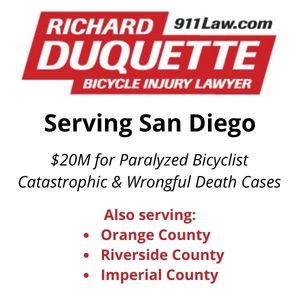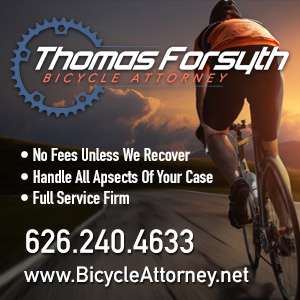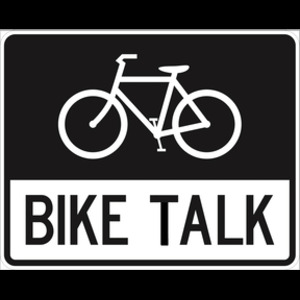Sometimes bad news is good.
Or at least, not as bad as it could have been. Because last weekend’s three cycling fatalities could have easily been four.
Cristin Zeisler was riding on PCH last Saturday morning when she was hit by large passenger van that kept going after knocking her off her bike.
We’ll let her tell the story.
The details of my accident are as follows: I was riding north on PCH on Saturday 9/15. Around 9am, as I approached the Porto Marina turnout, a large passenger van/shuttle hit me as it passed. I was thrown over the handlebars and landed primarily on my left shoulder (although my head, hip, and knee also took some of the impact). The van’s rear wheel missed running over my head by no more than 6 inches. I remained alert and vigilant throughout the impact and aftermath. I attempted to make note of the van’s license plate or other identifying marks, but it did not stop or slow at all so I was not able to get any details.
I’ve searched dozens of Google images to try to find a photo that matches what I saw. I haven’t found a perfect fit yet. The attached image comes is closest I’ve found so far — however, “my” van looked a little “older” and I believe it was only 5 windows long (not 6) and that the frames around the windows were white, not black. Also, the back portion of “my” van had an advertising billboard type of thing below the window, on its lower half. I have no idea what it was an ad for, but the main colors I remember from it were blue and green.
A girl in the Marina Porto parking area saw me hit the ground and she came over to check on me and call 911 and she stayed until the police and EMS arrived. I did not get her name or number, but the officers on the scene seemed to talk with her at length while the EMS guys were checking me out. I assume the on-scene officers got her info.
I was transported to UCLA via ambulance. About 45 mins after I got to UCLA, another officer (Yoon) came to interview me and he issued a little tiny form (sort of like a receipt) to let me know that a felony hit and run report was filed. I have not yet followed up to get a copy of the “full” report yet.
Thankfully, despite suffering a broken clavicle — and a busted bike — Crisitin is relatively okay.
It could have been a lot worse.
She thinks she was hit when the van gave her far less than three feet passing distance, sideswiping her as the driver tried to slip by.
That’s something that would have been clearly illegal if our governor hadn’t vetoed last year’s three foot passing law. Let’s hope he has enough sense to sign this year’s version, before more cyclists are sent to the hospital, or worse, thanks to his pen.
And let’s find the driver who ran her down so he — and the company he or she works for — can be held accountable.
………
The Daily Pilot offers a nice look at nutritionist Sarah Leaf, who was killed by a right-turning truck while riding in Newport Beach on Friday. Photos on the Orange County Bicycle Coalition website show a young woman with a lovely smile; maybe if the driver had seen that smile — let alone her bike — he might not have run her over.
Meanwhile, the paper remembers Dr. Catherine “Kit” Campion Ritz, also killed while riding her bike over the weekend, as a caring and well-respected physician.
“Dr. Kit Campion was a warm, engaging leader, respected and loved by her patients, physician colleagues, nurses and health-care professionals throughout Orange County,” said Diane Laird, CEO of Greater Newport Physicians, which has more than 550 members. “She worked tirelessly to ensure that members of all the communities we serve had access to the best health care.”
The Daily Pilot also confirms that she used her maiden name professionally; she was reportedly riding with her husband when she was killed just four miles from her home.
But can we please get them to stop calling it an accident?
It was a collision — not an accident — right up to the moment the coward behind the wheel stepped on the gas pedal to run away.
And then it became a crime. As if it wasn’t already when he drifted into the bike lane and ran down an innocent woman from behind without slowing down.
Meanwhile, Corona del Mar Today says the investigation continues into both collisions. Police are looking for the driver of the large black pickup that killed Campion Ritz, possibly a 2001 to 2004 Toyota Tacoma with significant front end damage.
Frank Peters provides photos of the collision scenes and ghost bikes for both victims on bikeNewportBeach. He also sends word that 150 people turned out for a special meeting of the Citizens Bicycle Safety Committee Monday night to share their heartbreak over the two deaths. And that Newport Beach Police Chief Johnson, who lost his own brother in a traffic collision, promised an imminent arrest in the hit-and-run.
Corona del Mar Today reports on the meeting.
Correction: Earlier I wrote that Chief Johnson lost his brother in a bicycling collision; it was actually a motor vehicle collision. Thanks to Amy Senk of Corona del Mar Today for the correction.
Update: An arrest has been made in the case.
………
After all the bad news, maybe you could use a little smile. And frankly, I don’t know how it’s possible to watch this video without your lips turning up at least a little.
No, it’s not bike related. In fact, I don’t think there’s a bike in it.
Just a loving family, and one of the sweetest little girls you’ll ever meet, should you be so lucky. It’s a day in the life of a K/1st grade child with Down Syndrome.
And she’s the daughter of my good friends at Altadenablog.








